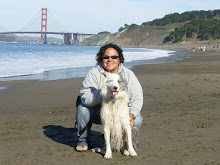When a Killer Kills : Discovery News
Posted using ShareThis
The death of trainer Dawn Brancheau today at SeaWorld Adventure Park in Orlando, Florida at the hands of Tilikum, one of the largest killer whales in captivity, was a shocking, terrible tragedy. There are no words for her family and loved ones, whose loss is beyond measure.
Even more disturbing, perhaps, is the fact that captive Orcas are regularly involved in the deaths of trainers. Tilikum himself, a 12,000 pound bull, killed his trainer at Sealand of the Pacific in 1991. The body of a homeless man was found draped across his back at SeaWorld in 1999.
Brancheau's death is the second in just a couple of months. Alexis Mertinez, a trainer at Loro Parque in Tenerife died in late December after having his chest severely compressed by a different whale "not considered completely predictable" who was known to "play rough."
The list goes on, tallying up near two dozen attacks -- most non-fatal -- since the 1970's. Together with today's sad, unpredictable incident, such tragedies raise a few important questions about training and keeping killer whales in captivity.
Were Tilikum a lion, a wolf, or a grizzly bear, would the death of a trainer be so surprising to us? We have a special fascination with whales, and killer whales in particular. We know they are immensely powerful but also incredibly intelligent, social, and emotional animals. Images of trainers hugging them and playfully tossing them fish are the first things that pop to mind.
But perhaps because of their status in our culture, we forget that they are multi-ton apex predators. In the wild they ruthlessly hunt down and eat seals, sea lions, and just about anything else they want.
More broadly, what provokes an attack like this, and why do they keep happening?
"Whether you call it boredom, aggression, stir-crazy, or it just being a wild animal, these accidents occur, and shouldn't be taken for granted," Courtney Vail of the Whale and Dolphin Conservation Society (WDCS) told Discovery News (a call made to SeaWorld was not immediately returned). She went on to suggest that it's the venue in which we view these animals -- a brightly lit SeaWorld tank, with music, applause, and sensational tricks -- that makes us think these animals are happy go-lucky animals content with life in captivity.
We can't see into the mind of an animal, of course. But according to Vail, 136 Orcas have been taken into captivity from the wild since 1961. Of those, 123 have died, with an average lifespan of four years once captured. For a species that averages 35 years in the wild, that's a pretty poor public health record.
The bottom line is that these animals are very lucrative, as are the relationships trainers establish with them for shows. A 2004 investigative report by Sally Kestin of the South Florida Sun-Sentinel revealed that SeaWorld paid $875,000 for an Orca in the mid-1990s. Though WDCS hasn't been able to find any current numbers, Vail speculated that the whales likely now sell for "millions of dollars."
Being a campaigns director for WDCS, Vail's stance is that no whales should be kept in captivity. Of the 41 Orcas currently alive in captivity around the world, only 13 are wild. Still, captive breeding programs need new blood from wild populations to maintain genetic viability. Animals will continue to be harvested from the wild, simply because they are money makers.
And for the same reason, the position of SeaWorld trainer to a killer whale isn't llikely to disappear any time soon, no matter how dangerous a job it is.
Subscribe to:
Post Comments (Atom)





No comments:
Post a Comment